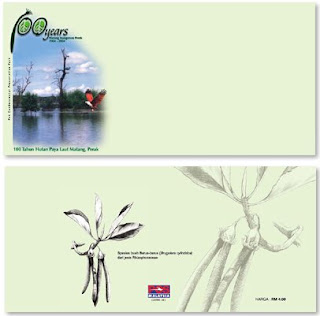 Besides plants, the mangrove habitat also houses a large number of animals, from the most minute (zooplankton) to the largest reptile, i.e. the Estuarine crocodile. One of the most commonly found inhabitants of the mangrove forest is the long-tailed macaque-Macaca fascicularis. These monkeys invade the mangrove forest during the falling tide to feed on crabs and shellfish.
Besides plants, the mangrove habitat also houses a large number of animals, from the most minute (zooplankton) to the largest reptile, i.e. the Estuarine crocodile. One of the most commonly found inhabitants of the mangrove forest is the long-tailed macaque-Macaca fascicularis. These monkeys invade the mangrove forest during the falling tide to feed on crabs and shellfish.The Gedabu fruit Sonneratia ovata or more commonly known as the Mangrove apple can be eaten by man and it is also a favorite of the Painted Terrapin. The fruit can be made into juice and also used for the treatment of sprains, bleeding and hemorrhoid. Its wood can be used as firewood, poles and in the construction of houses. In addition, insects such as moth can be found throughout the mangrove forest.
There are 28 fishing villages in the vicinity of the Matang Mangroves. Besides fishing in the sea, the fishermen also carry out aquaculture farming, i.e. breeding of fish in cages and cockle farming. The cockles (Anadara granosa) were first commercially farmed by the village headman in Bagan Panchor, Perak, in 1984. Cockles from Matang fetch a good price in neighboring countries such as Thailand, Singapore and Indonesia.
 The Matang Mangroves environment is a very productive ecosystem. It supports the food chains of various wildlife comprising fish, crustaceans, birds, small mammals and invertebrates. It is the feeding ground for birds such as the Lesser adjutant-Leptoptilos javanicus and Brahminy kite-Haliastur indus. These birds eat various types of food, including plankton, aquatic plants, worms, crustaceans, molluscs and fish.
The Matang Mangroves environment is a very productive ecosystem. It supports the food chains of various wildlife comprising fish, crustaceans, birds, small mammals and invertebrates. It is the feeding ground for birds such as the Lesser adjutant-Leptoptilos javanicus and Brahminy kite-Haliastur indus. These birds eat various types of food, including plankton, aquatic plants, worms, crustaceans, molluscs and fish.In addition, migratory birds also make pit stops at the Matang Mangroves to feed before flying on to New Zealand or to stay there for winter. These birds include the Eurasian Duck-Anas penelope, Chinese egretta eulophotes, Common sandpiper-Actitis hypoleucos and many more.
100 Years Matang Mangroves, Perak
If an area that has been worked on contains less than 90% of natural seedlings, replanting will be carried out on the area. Two species that are commonly planted are Bakau minyak-Rhizophora apiculata and Bakau kurap-Rhizophora mucronata at a spacing of 1.2m x 1.2m and 1.8m x 1.8m respectively. Present planting involves the prescription of bare root propagules and potted seedling as planting materials, depending on suitability of the sites and the presence of pests.
 Technical Details
Technical DetailsDate of Issue : 4-Oct-2004
Stamp Value : 30 Sen (Se-tenant); RM1 (Se-tenant)
Sheet Content :20 Stamps
Stamp Size : 30mm X 40mm
Perforation : 14
Miniature Sheet Denomination : RM2.00
Miniature Sheet Size : 100mm X 70mm
Stamp Size in Miniature Sheet : 30mm X 40mm
Paper : Watermarked, Phosphor Coated
 Printing Process : Lithography
Printing Process : LithographyPrinter : Secura Security Printing Sdn. Bhd.
Designer : Hazel Design
First Day Cover Value : 30 Sen
Presentation Pack Value :RM 4.00
Folder Value :RM 5.00
|
|








0 comments:
Post a Comment